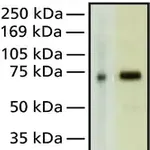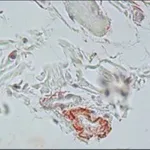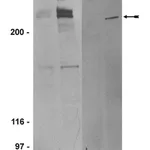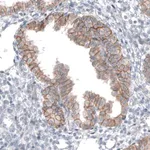
Merck Anti-phospho-ATM (Ser1981) Antibody, clone 10H11.E12
✨AI 추천 연관 상품
AI가 분석한 이 상품과 연관된 추천 상품들을 확인해보세요
연관 상품을 찾고 있습니다...
Anti-phospho-ATM (Ser1981) Antibody, clone 10H11.E12
clone 10H11.E12, Upstate®, from mouse
A-T, mutated, AT mutated, TEL1, telomere maintenance 1, homolog, ataxia telangiectasia mutated, ataxia telangiectasia mutated (includes complementation groups A, C and D), ataxia telangiectasia mutated protein, human phosphatidylinositol 3-kinase homolog
Ataxia telangiectasia mutated kinase (ATM) and ataxia telangiectasia and Rad3-related kinase (ATR) are related kinases that regulate cell cycle checkpoints and DNA repair. Mutation in the ATM gene results in the autosomal recessive disease ataxia telangiectasia (AT). The identified substrates for ATM are p53, p95/NBS1, MDM2, Chk2, BRCA1, CtIP, 4E-BP1 and Chk1. The essential requirement for the substrates of ATM/ATR is S/TQ. Hydrophobic amino acids at positions -3 and -1, and negatively charged amino acids at position +1 are positive determinants for substrate recognition by these kinases. Positively charged residues surrounding the S/TQ are negative determinants for substrate phosphorylation. The complex phenotype of cells derived from patients with AT suggests that ATM has additional cellular substrates. In unirradiated cells, ATM is present as an inactive homodimer or multimer. Double-stranded breaks in DNA caused by ionizing radiation cause rapid ATM kinase activation through dissociation of this complex and ATM autophosphorylation at Ser1981.
🏷️Merck Sigma 상품 둘러보기
동일 브랜드의 다른 상품들을 확인해보세요

Merck Sigma
Merck Anti-MeCP2 antibody, Mouse monoclonal
888,800원

Merck Sigma
Merck Monoclonal Anti-Elastin antibody produced in mouse
625,300원

Merck Sigma
Merck Anti-phospho-ATM (Ser1981) Antibody, clone 10H11.E12
205,900원

Merck Sigma
Merck Anti-PLAT antibody produced in rabbit
370,530원

Merck Sigma
Merck Anti-TMEM30A antibody produced in rabbit
817,800원
배송/결제/교환/반품 안내
배송 정보
| 기본 배송비 |
| 교환/반품 배송비 |
|
|---|---|---|---|
| 착불 배송비 |
| ||
| 교환/반품 배송비 |
| ||
결제 및 환불 안내
| 결제수단 |
|
|---|---|
| 취소 |
|
| 반품 |
|
| 환급 |
|
교환 및 반품 접수
| 교환 및 반품 접수 기한 |
|
|---|---|
| 교환 및 반품 접수가 가능한 경우 |
|
| 교환 및 반품 접수가 불가능한 경우 |
|
교환 및 반품 신청
| 교환 절차 |
|
|---|---|
| 반품 절차 |
|
